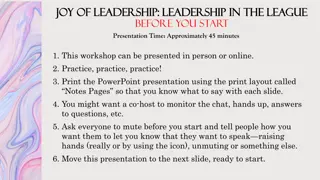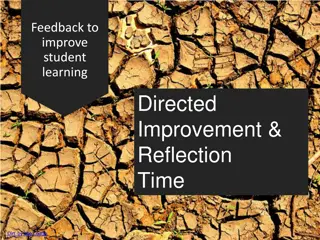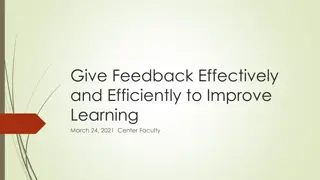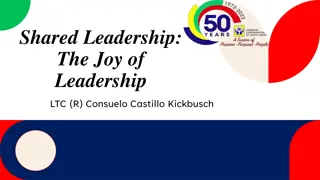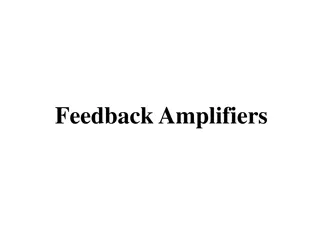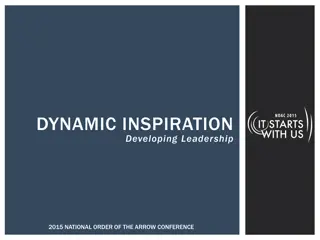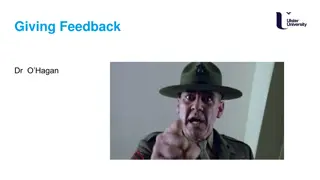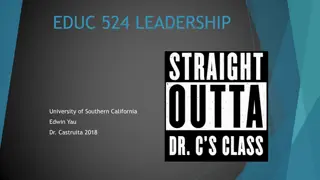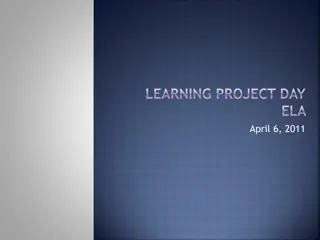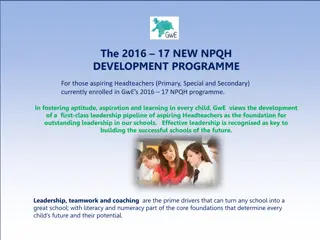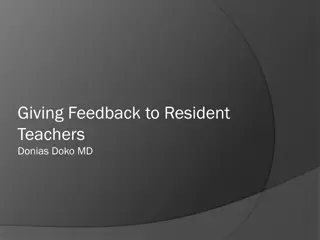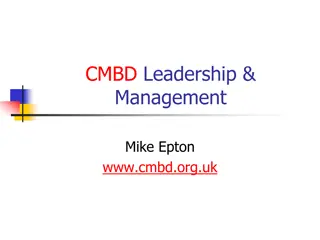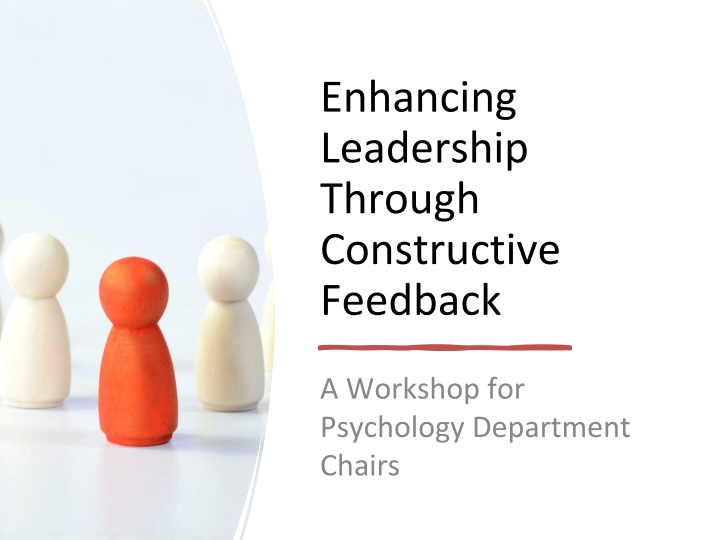
Effective Leadership Workshop for Psychology Department Chairs
Equip Psychology Department Chairs with skills to solicit, process, and respond to feedback, fostering open communication for enhanced leadership effectiveness. Workshop covers feedback importance, strategies, processing skills, and non-defensive response techniques.
Download Presentation

Please find below an Image/Link to download the presentation.
The content on the website is provided AS IS for your information and personal use only. It may not be sold, licensed, or shared on other websites without obtaining consent from the author. If you encounter any issues during the download, it is possible that the publisher has removed the file from their server.
You are allowed to download the files provided on this website for personal or commercial use, subject to the condition that they are used lawfully. All files are the property of their respective owners.
The content on the website is provided AS IS for your information and personal use only. It may not be sold, licensed, or shared on other websites without obtaining consent from the author.
E N D
Presentation Transcript
Enhancing Leadership Through Constructive Feedback A Workshop for Psychology Department Chairs
Workshop Overview This workshop is designed to equip Psychology Department Chairs with the knowledge and skills necessary to effectively solicit, process, and respond to feedback from faculty and staff. By fostering a culture of open communication and continuous improvement, department chairs can enhance their leadership effectiveness and promote a positive departmental environment.
Workshop Objectives 1. Understand the Importance of Feedback 2. Develop Strategies to Solicit Constructive Feedback 3. Enhance Skills in Processing Feedback 4. Respond to Feedback Non-Defensively
Introduction to the Role of Feedback in Leadership - Discussion: The significance of feedback in leadership development. - Activity: Reflective exercise on past experiences with receiving feedback.
Why Feedback Matters Builds trust and collegiality: Promotes an open and supportive department culture (Bennis, 2009). Enhances decision-making: Provides diverse perspectives for informed choices (Edmondson, 2012). Improves departmental operations: Identifies areas for growth and improvement (Heifetz & Linsky, 2002). Fosters professional development: Helps leaders refine their approaches (Argyris, 1991).
Challenges to Receiving Feedback Personal defensiveness: Fear of criticism or failure (Stone & Heen, 2014). Power dynamics: Hesitation due to hierarchical structures (Eagly & Carli, 2007). Poor communication channels: Lack of structured avenues for feedback (Heifetz & Linsky, 2002). Cultural or individual differences: Varying comfort levels with feedback exchange (Ting- Toomey & Chung, 2012). What are your barriers?
Practice With a partner, ask a question about workload in a less threatening manner, in a more threatening manner. What makes a question from faculty threatening to you? What is the worst thing that would happen? How can you rethink/reframe your response?
Keys to Effective Feedback Engagement Cultivate a growth mindset (Dweck, 2006). Establish transparent processes for feedback collection (Heifetz & Linsky, 2002). Demonstrate active listening and empathy (Rogers & Farson, 1987). Respond constructively and follow up with action (Stone & Heen, 2014).
- Presentation: Strategies to build an environment where feedback is encouraged and valued. Creating a Culture of Open Communication - Case Study: Analysis of a department that successfully implemented open communication practices.
Structure Feedback Mechanisms Use anonymous surveys or suggestion boxes for sensitive topics (Heifetz & Linsky, 2002). Schedule regular one-on-one meetings to foster open communication (Stone & Heen, 2014). Conduct faculty forums for collective input on significant departmental decisions (Bennis, 2009).
Practice Active Listening Focus fully on the speaker: Avoid distractions during discussions (Rogers & Farson, 1987). Paraphrase and reflect: Confirm understanding by summarizing faculty points (Stone & Heen, 2014). Ask open-ended questions: Encourage elaboration and clarify intent (Ting-Toomey & Chung, 2012).
Example tough question "Given the department s budget allocations and faculty workload distribution, why are track faculty expected to take on increasing service and administrative burdens while adjunct hiring continues to rise? Can you provide transparency on how these decisions align with our mission and long-term strategic goals, and whether faculty input has genuinely influenced these outcomes?"
Case Study Activity Applying Feedback Best Practices Discussion Questions: How would you respond in the moment? What follow-up actions would you take? How might you use this feedback to improve departmental policies?
Case Study Activity Applying Feedback Best Practices
Manage Emotional Responses Take a pause if feedback feels critical; respond calmly (Stone & Heen, 2014). Avoid personalizing feedback: Focus on the message, not the messenger (Eagly & Carli, 2007). Practice self-awareness: Recognize emotional triggers and address them constructively (Argyris, 1991).
- Interactive Session: Exploring methods such as anonymous surveys, one- on-one meetings, and feedback workshops. Techniques for Soliciting Constructive Feedback - Role-Playing Exercise: Practicing soliciting feedback in various scenarios.
Processing Feedback Objectively - Workshop: Identifying common cognitive biases that hinder objective processing of feedback. - Group Discussion: Sharing techniques to maintain objectivity and focus on growth opportunities.
- Lecture: Understanding the psychological underpinnings of defensiveness and strategies to manage it. Responding to Feedback Without Defensiveness - Activity: Developing personalized action plans to respond to feedback constructively.
Implementing Feedback for Personal and Departmental Growth - Panel Discussion: Insights from experienced department chairs on integrating feedback into leadership practices. - Action Planning: Participants outline steps to apply workshop learnings in their departments.
Key Insights from Literature and Online Resources - The Role of Feedback in Leadership: Essential for self- awareness and improvement. - Soliciting Feedback: Encourage through safe, regular channels. - Responding Non- Defensively: Focus on growth, express gratitude, and develop actionable steps. - Processing Feedback: Listen, clarify, and reflect without judgment.
References Argyris, C. (1991). Teaching smart people how to learn. Harvard Business Review, 69(3), 99 109. Bennis, W. (2009). On becoming a leader. Basic Books. Dweck, C. S. (2006). Mindset: The new psychology of success. Random House. Eagly, A. H., & Carli, L. L. (2007). Through the labyrinth: The truth about how women become leaders. Harvard Business Press. Edmondson, A. C. (2012). Teaming: How organizations learn, innovate, and compete in the knowledge economy. Jossey-Bass. Heifetz, R. A., & Linsky, M. (2002). Leadership on the line: Staying alive through the dangers of leading. Harvard Business School Press. Rogers, C., & Farson, R. (1987). Active listening. University of Chicago Press. Stone, D., & Heen, S. (2014). Thanks for the feedback: The science and art of receiving feedback well. Viking.

